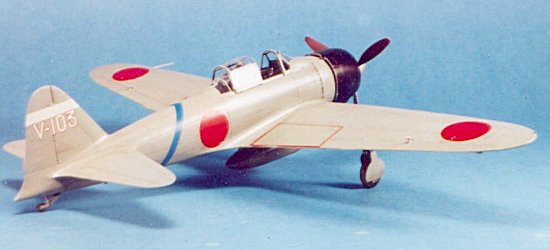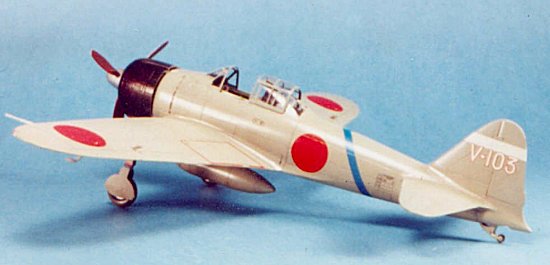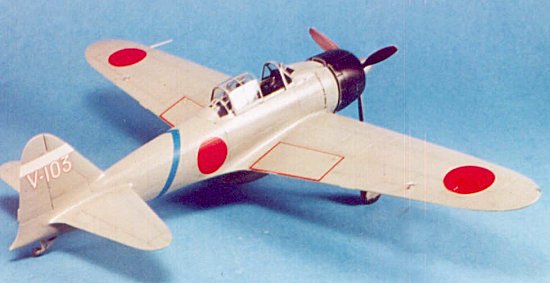
|
KIT: |
Hasegawa 1/48 A6M2 Model 21 Zero |
|
KIT # |
9394 |
|
PRICE: |
$29.98 |
|
DECALS: |
Two aircraft |
|
REVIEW & |
|
|
NOTES: |
|

|
HISTORY |
At the time of its appearance in combat over China in September 1940, the Mitsubishi A6M2 "Zero" was arguably the most advanced single-seat single-engine fighter in the world. That it was designed to fly from aircraft carriers made it even more amazing. Its heavy armament of 2 20mm canon and 2 7.72mm machine guns was only equaled by the Messerschmitt Bf-109E. There was not a contemporary fighter in the world it could not fly rings around in combat. Even more remarkable was its range, which was at least four times as great as any of its contemporaries; at the outset of the Pacific War its opponents would end up crediting the Imperial Japanese Navy with more aircraft carriers than they had, since it was inconceivable that a fighter could fly from Formosa to the Philippines and have time for 45 minutes of combat before returning - which the Zero accomplished regularly. When the U.S. invaded Guadalcanal, the Japanese would regularly send Zeros from Rabaul to the battle front, a distance of 600 miles one way, over water all the way, until new bases could be constructed at Bougainville.
 The Zero paid for this
spectacular performance with a very light structure that foreswore both
defensive armor and self-sealing fuel tanks, since its engine was no more
powerful than any of its contemporaries, being a Sakae-11 of 1,200 horsepower.
Its maneuverability above 250 m.p.h. was seriously degraded by stiff ailerons,
and at over 300 m.p.h. its maneuverability advantage was largely negated. Almost
any Allied fighter, by the fact of the additional weight of armor and
self-sealing fuel tanks, could dive away from a fight with a Zero if need be.
With such a light structure, one good burst from the American armament of six
.50 caliber machine guns would explode a Zero if the pilot could hold the Zero
in his sights long enough.
The Zero paid for this
spectacular performance with a very light structure that foreswore both
defensive armor and self-sealing fuel tanks, since its engine was no more
powerful than any of its contemporaries, being a Sakae-11 of 1,200 horsepower.
Its maneuverability above 250 m.p.h. was seriously degraded by stiff ailerons,
and at over 300 m.p.h. its maneuverability advantage was largely negated. Almost
any Allied fighter, by the fact of the additional weight of armor and
self-sealing fuel tanks, could dive away from a fight with a Zero if need be.
With such a light structure, one good burst from the American armament of six
.50 caliber machine guns would explode a Zero if the pilot could hold the Zero
in his sights long enough.
During the first year of the Pacific War, the myth of the Zero was considerably enhanced by the fact that it was flown by pilots who were among the best in the world - the pre-war trained fighters of the Imperial Japanese Navy - who not only averaged some 800 flying hours as compared with half that much or less for their opponents, but could count significant time and experience in actual combat over China during the Sino-Japanese conflict that had raged since 1937.
Unfortunately for the Japanese, the A6M2 Model 21 - the first Zero to see combat in significant numbers - was also the best of the series. Successive changes did not improve performance significantly as compared with the increased performance of the new Allied types that entered combat beginning in late 1942 with the arrival of the P-38 Lightning in New Guinea. Coupled with new tactics that played to the strengths of the Allied fighters and against the weaknesses of the Zero that were discovered when an A6M2 that crashed in the Aleutians was flight tested, and the fact that the Japanese were unable to replace their pilot losses with similarly-trained personnel, and the day of the Zero was basically over by the conclusion of the Guadalcanal campaign.
Saburo Sakai:
Saburo Sakai, who died last October 24, 2000, was the top-scoring surviving Japanese ace of the Pacific War, with approximately 65 victories, 60 of which were scored between December 7, 1941, when the Tainan Air Group went to war over the Philippines, and August 7, 1942, when he was severely injured by the defensive fire of the tail gunners while attacking a formation of SBD Dauntlesses on the first day of the invasion of Guadalcanal.
A pre-war trained pilot who had seen combat over China in both the A5M and A6M between 1938 and 1941, Sakai was a descendant of samurai who had lost their social position in the aftermath of the Meiji Restoration and the abolition of feudalism in Japan in the 1870s. He had enlisted in the Imperial Navy as an escape from the life of a poor peasant. He found a brutal regime in which the enlisted men were treated like animals. He managed to get into Naval Aviation and train as a pilot.
Among his victories during the early days of the Pacific War was the B-17 flown by Colin P. Kelly, a brave man who became a "manufactured hero" whose public exploit - attacking and sinking the battleship "Haruna" - bore no resemblance to the real events. While many have believed over the years that Kelly received the Medal of Honor for this "event," in fact he received the Silver Star for staying with the badly shot-up bomber and holding it level long enough for the rest of his crew to bail out after Sakai's attacks on them; when he attempted to bail out himself, the B-17 went out of control and crashed. Sakai himself was amazed he was able to shoot down the huge airplane, which almost over-awed he and his two wingmen when they caught up with it following its unsuccessful attack on the invasion fleet in Lingayen Gulf.
 Sakai came very close
to changing history in April 1942. By that time the Tainan Wing was based at Lae
on the northern coast of New Guinea, and was engaged in gaining air superiority
over the Allied forces at Port Moresby, prior to the coming Japanese invasion.
Among their opponents were the recently-arrived B-26 Marauders of the 22nd Bomb
Group, which made several unescorted low level daylight raids on Lae, during
which the Japanese exacted high losses on the unit.
Sakai came very close
to changing history in April 1942. By that time the Tainan Wing was based at Lae
on the northern coast of New Guinea, and was engaged in gaining air superiority
over the Allied forces at Port Moresby, prior to the coming Japanese invasion.
Among their opponents were the recently-arrived B-26 Marauders of the 22nd Bomb
Group, which made several unescorted low level daylight raids on Lae, during
which the Japanese exacted high losses on the unit.
Badly wounded and blinded in one eye from his encounter with the dive bombers over Guadalcanal on August 7, Sakai performed one of the great feats of aviation in flying his shot-up Zero 600 miles over open ocean, unable to see out of his one good eye due to blood flowing from a bad head wound, all the way back to Rabaul. He was sent back to Japan to recover, and did not enter combat again for another two years; this likely contributed to his surviving the war, since almost all the men he had served with in the Tainan Wing would die in the Solomons Campaign, which was the graveyard of the Imperial Navy's air forces.
|
THE KIT |
Hasegawa's A6M2 Model 21 Zero was first released in the mid- 1990s, the first of an entire series of kits that will by next Spring encompass every version of the Zero built. While the Tamiya A6M2 introduced in the early 1970s had raised the bar as regarded kit construction standards when released, and still makes up into a beautiful model, the Hasegawa offering is more "state of the art." This particular release, "Samurai Pilot" is one of several limited releases of the kit, with decals to provide markings for three aircraft flown by Sakai, including the one involved in his epic Guadalcanal flight.
 This past summer, during
the Hasegawa Spitfire IX Flame Wars on the modeling internet, where it was
conclusively proved that the newly-released Spitfire IX had committed the eighth
deadly sin of being Five Scale Inches Too Short, several of the Lord High
Executioners alleged that the Hasegawa Zero series suffered from the same
deficiency, and that the Tamiya Zero was the kit that was still "the only one
that is dimensionally correct." Well, with all disrespect to their Lordships,
this reviewer took one of my other Hasegawa Zero models and measured it against
the Tamiya A6M2 Model 21 that has sat on my shelf since back when Utah Raptors
were building plastic models, and the following Momentous Discovery was made:
This past summer, during
the Hasegawa Spitfire IX Flame Wars on the modeling internet, where it was
conclusively proved that the newly-released Spitfire IX had committed the eighth
deadly sin of being Five Scale Inches Too Short, several of the Lord High
Executioners alleged that the Hasegawa Zero series suffered from the same
deficiency, and that the Tamiya Zero was the kit that was still "the only one
that is dimensionally correct." Well, with all disrespect to their Lordships,
this reviewer took one of my other Hasegawa Zero models and measured it against
the Tamiya A6M2 Model 21 that has sat on my shelf since back when Utah Raptors
were building plastic models, and the following Momentous Discovery was made:
The two kits are dimensionally the same, folks. I know, I know, it's completely shocking - here, put this plastic bag over your head and breathe deeply, repeatedly.
|
CONSTRUCTION |
Construction of this kit has been covered in at least several other reviews here at Modeling Madness, and there is nothing new to repeat. It goes together as advertised, with excellent fit.
|
PAINT & DECALS |
Painting:
About a year ago, over at the truly-excellent Japanese Aircraft Modeling Site (www.j-aircraft.com), several of the Sensei made the discovery that the shade of grey that has previously been used by modelers to do early-war Zeros is wrong. The color is a more greenish-grey color, also called a "willow green," which has been compared to "concrete grey" and which may be related to the prewar German RLM63 Grey, which was on several Heinkel aircraft which were bought in the 1930s by the IJN.
My personal belief is that the shade of RLM02 Grey produced by Gunze-Sanyo - which is much lighter and greyer than the other RLM02 paints created by other manufacturers (all of which closely resemble each other) - is actually based on the pre-war RLM63 Grey, which was a lighter grey-green than RLM02. At any rate, this is the color I have now used on this A6M2 Model 21, and on an A6M2-N "Rufe" I made last year when the information first became available.
 This pre-war paint was
much higher-quality than the paints that came into use after the war began. It
was a semi-gloss paint and highly-resistant to salt water corrosion. While the
airplanes were dinged in the course of operations, the badly-faded, chipped look
one associates with Japanese aircraft in the Pacific War is incorrect for the
early production Zeros used up through 1942.
This pre-war paint was
much higher-quality than the paints that came into use after the war began. It
was a semi-gloss paint and highly-resistant to salt water corrosion. While the
airplanes were dinged in the course of operations, the badly-faded, chipped look
one associates with Japanese aircraft in the Pacific War is incorrect for the
early production Zeros used up through 1942.
This was particularly true for the airplane I decided to do, the Zero flown by Sakai in December 1941, when he shot down Colin P. Kelly. The war was less than two weeks old at this point, and the aircraft was operating from fully-developed, permanent airfields on Formosa. Thus, it has some few dings, and some exhaust stains, but overall is in only a slightly less-clean and well-maintained condition than it would have been aboard a carrier at this time.
When I pre-shaded the model for painting, I used dark red-brown instead of black for this. Japanese aircraft were painted in a primer this shade, and I opted to get a brownish shade through the final grey coat for the shadowing. I used Tamiya XF-64 "Red Brown" for this, which was also used on the rear of the propeller blades for anti-glare. The overall grey is Gunze-Sanyo H-70 "Grey". The black cowl was painted with Tamiya X-18 "Semi-Gloss Black," which I also used for the landing gear legs. The wheel wells and inner surfaces of the gear doors were painted with Gunze-Sanyo H-89 "Metallic Green." The cockpit interior had been painted with Gunze-Sanyo H-312, "Light Green" which seems a close approximation of Mitsubishi Interior Green. The spinner and front of the prop blades were painted with SnJ Aluminum.
Decals:
I used the kit decals throughout, though I used the numbers on the rudder "V-103" from the "Tainan Air Group" limited release decal sheet. For those who have had problems with Hasegawa kit decals, I recommend you get Gunze Sanyo's "Mr. Mark Softer" decal solvent. If you put this on the surface, then put the decal over it, the decal will melt down just perfectly. This decal solvent also works well with decals printed by Cartograph, which are thicker than decals printed by Micro-Scale.
Final Assembly and Weathering:
I used Tamiya "smoke" for the exhaust stains, and dry-brushed a very little bit of paint chipping with Testors Model Master "Aluminum" (non-buffing). I then shot a light coat of thinned Testor's Dullcote, so that the finished model had a barely semi-gloss finish.
|
CONCLUSIONS |
The Hasegawa series of Zero fighters are excellent. I have heard there is a price increase associated with this "Samurai Pilot" release, but it still comes out to the same amount one could spend on an earlier release and aftermarket decals. The result either way is a very good looking model of an important airplane.
Thanks to Marco Polo Imports for the review kit.
If you would like your product reviewed fairly and quickly by a site that has thousands of visits a day, please contact me or see other details in the Note to Contributors.